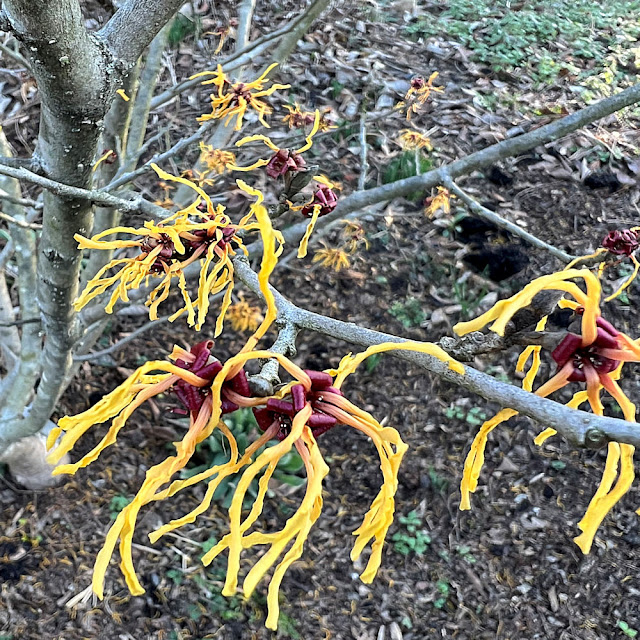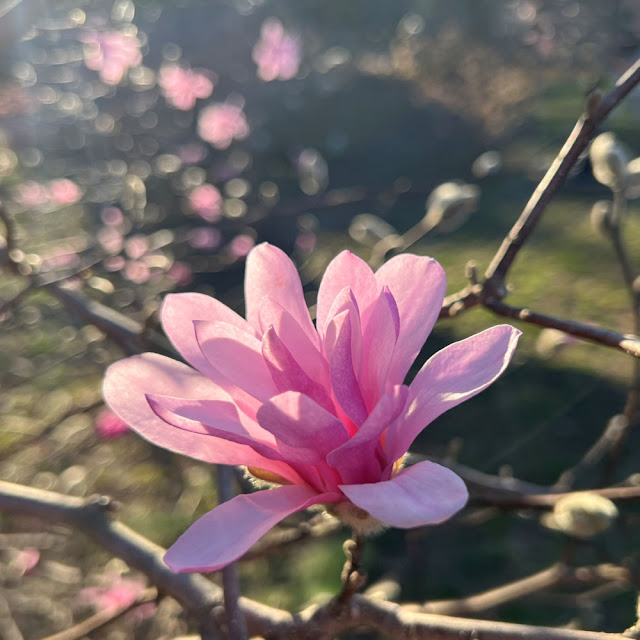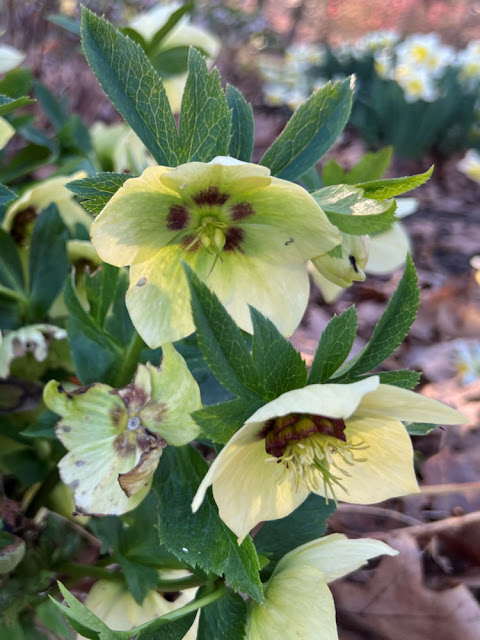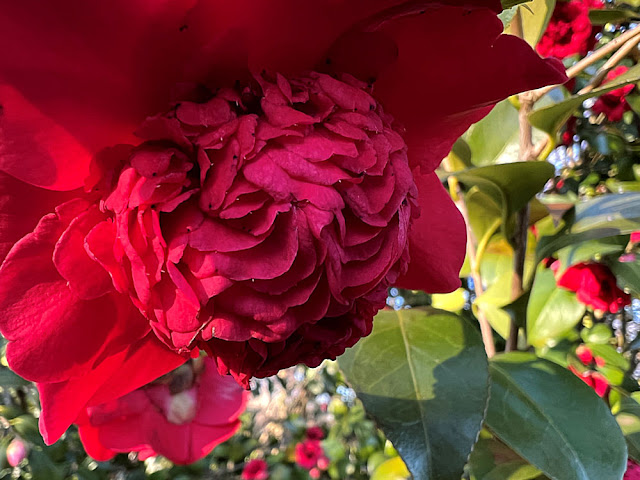The first two photos are of Witch Hazel. It is known by several names: American witch-hazel, Common witch hazel, Striped alder, Tobacco-wood, Spotted alder, Water-witch, Snapping Hazelnut, Winterblooms and Witchhazel Witch-hazel! Its botanical name is Hamamelis virginiana.
Witch hazel was used quite commonly in the 20th century for locating water sources. The practice, called dowsing or water witching, which is still occasionally used. You can read about the practice here. In dowsing, a forked stick of the witch hazel is held perpendicular to the ground and moved slowly over it. The belief is that when a water source is directly under the stick, it will dip or jump. I also wrote about Witch Hazel in my post at this link, along with other photos around the garden.
Next, the Star Magnolia (Botanical name: Magnolia stellata). It is also known as the Royal star magnolia.
I had a hard time choosing between the photos I took of this ornamental shrub, deciding to share several today.
It grows from 5 to 8 feet in height and can cope with cooler climates. It does, however, need a sunny spot in the garden, with some partial shade for protection during the summer months. In fact, it is advised to plant in an area that will protect the magnolia from winds and frost. Otherwise, the flowers may be discolored as the buds open before the leaves appear.
Star Magnolia is a small, slow-growing shrub native to Japan. As you can see, compared to other magnolias, it has much narrower petals resembling a star-like shape, hence the name.
 It has 3-4" fragrant white or pink flowers with dark green leaves and a gray bark. It certainly was lovely to see it blooming on our way into the garden.
It has 3-4" fragrant white or pink flowers with dark green leaves and a gray bark. It certainly was lovely to see it blooming on our way into the garden.
The back of the house that I have always loved. Its history can be read here, but in part it was built in 1784 by John Moss.
As it used to be back then, the front of the house courtesy of the Fairfax County Park Authority and found on the above website.
Next you can see it from its side view. It is near one of the entrances near the parking lot.
More daffodils...
We planted these in front of our own home and I am hoping they survived the winter.
Lastly, the tree towered above me with a profusion of blooms. It is the Japanese camellia, botanical name Camellia japonica, and as the name would infer, it is native of Japan. Also known as Common camellia and Rose of Winter.
It can grow up to 49 feet and does best in partially shady spots with rich, well-drained soil. It also has very little fragrance. I read that it can be given coffee grounds as long as it is mixed into a well-prepared compost. Coffee grounds are rich in nitrogen, as well as some other micronutrients. Japanese camelia's have been known to live for over a century in the wild.
Many of the blooms were past their peak. Still very pretty though.
A small pink Japanese camelia was growing next to the larger tree, and those blooms were not quite as worn.
We had parked our car on the other side of the barrier at one of the entrances. Though people are welcome to stay in the garden until 6.00 p.m. after which it starts to get dark, the parking lot closes at 5.00 p.m. We didn't arrive until 4.40 p.m. and thought it wise to park outside on the road that leads into the garden.
 It has 3-4" fragrant white or pink flowers with dark green leaves and a gray bark. It certainly was lovely to see it blooming on our way into the garden.
It has 3-4" fragrant white or pink flowers with dark green leaves and a gray bark. It certainly was lovely to see it blooming on our way into the garden. 
















ReplyDeleteWitch hazels are interesting and unique!
I agree Angie :)
DeleteI did not know you needed to use the wood from witch hazel in search of water...I assumed any forked twig would do. I learned something
ReplyDeleteAnd the flowering trees are stunning.
Thank you Anni, I wonder if you could use another wood? I'll have to look into that.
DeleteMagnolias and camillias reminded me of our years living on the VA eastern shore.
ReplyDeleteI can understand that Dorothy. If I ever left Virginia I believe I would feel the same way :)
DeleteI've never seen witch hazel! What an interesting plant!
ReplyDeleteLove all the flowers...
hugs
Donna
Hi Donna, I don't think I ever saw it before I came to Virginia and started visiting the gardens around here. Thank you and hugs to you also :)
Deleteall the flowers are amazing! the star magnolia I WANT ONE love it. I did not know about the water witching being a witch hazel limb, thought it was any limb, i would love to see the witchhazel. can you smell witchhazel when you took the photos? I like the OLD photo of the house best of all, even though the brick home is gorgeous. I love old frame homes best of all houses
ReplyDeleteThank you Sandra, I was very much taken with the star magnolia :) I ought to find out why they use the plant for finding water, and why not others? That house has been a favorite of mine every since we first saw it years ago.
DeleteThat house is especially beautiful. I'd heard of the divining rods in the past but didn't know they were witch hazel. What a lovely walk.
ReplyDeleteGlad you enjoyed Jeanie, thank you :)
DeleteA pleasure to stop by love those magnolia
ReplyDeleteIt certainly was. I loved seeing all the spring flowers :)
Deletewhat a great day for a walk, in an awesome spot/garden. the star magnolia is a stunner, i am very happy you shared so many pictures of it. the shape of the flowers, the color, it is similar to the tulip magnolia but unique in it's own way!!
ReplyDeletethe witch hazel is so interesting, i don't think i have ever seen that before. the house is beautiful, were you able to go inside??
So glad Debbie, thank you :) You can go inside but we didn't this time. We keep telling ourselves we will book an afternoon tea there but haven't made it for that yet. They have a very nice dining room. Maybe this year :)
DeleteLovely post. I have longed wondered whether the stick senses the water or whether the human holding it is tapping into some unconscious ability. Some animals can sense magnetic fields for instance, perhaps we can too.
ReplyDeleteMakes you wonder doesn't it Linda? :) I have often wondered if humans over thousands of years lost certain abilities to sense many things.
DeleteThis is so springy! We are still wintery!
ReplyDeleteHi Jenn, I hope your springy weather comes soon :)
DeleteVery interesting info about witch hazel. I thought it was a medieval practice. I wouldn't mind testing it out.
ReplyDeleteSounds medieval doesn't it? :) I have often seen it done in movies set in the 1800s.
DeleteA fine spring stroll with you two. Thank you!
ReplyDeleteYou are very welcome Cloudia, glad you enjoyed it :)
DeleteI've heard of witch hazel but have never seen the plant before. Everything there looks so pretty. That house is quite nice and how amazing that it's standing after all these years.
ReplyDeleteHi Ann :) I remember being very surprised to see witch hazel for the first time, as I had only known it as the liquid in the bottle. This is going back a few years as we have been coming to this garden for many and it is where I first saw this plant. The house is wonderful and I'm glad they have preserved it.
DeleteA lovely post, I so enjoy seeing beautiful blooms.
ReplyDeleteAll the best Jan
Me too Jan, glad you enjoyed and all the best :)
DeleteMagnolia is so beautifully looking. I used to have a pair in my old house that I love photographing it very well
ReplyDeleteOh I would have loved to have this beauty in my own home. I also would have loved to see your photos :)
DeleteOur water well witchers used willow and probably got the same results.
ReplyDeleteThat's interesting, good to know. Thanks Red! :)
DeleteI am intrigued by the building. Wonderful blooms.
ReplyDeleteThank you Ashok, the building is one of my favorites around here. Glad you liked the blooms :)
DeleteThese are beautiful.
ReplyDeleteThank you William, they were beautiful flowers on display that day :)
DeleteI love to read about and see old historic houses. There is so much history behind them. Lovely flowers photos today, Denise. I especially love that single pink flower photo, it's the prettiest! No flowers yet here, we are buried in snow. Spring will come later for us. : )
ReplyDelete~Sheri
Same here Sheri, they are always so interesting and I enjoy reading about their history. Glad you enjoyed my post. I hope you get rid of your snow soon and that spring will be here before you know it :)
Delete